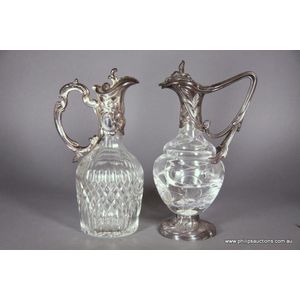Royal Worcester Ewer Vases by Edward Raby
You must be a subscriber, and be logged in to view price and dealer details.
Subscribe Now to view actual auction price for this item
When you subscribe, you have the option of setting the currency in which to display prices to $Au, $US, $NZ or Stg.
- Ewer / Pitcher - A type of jug with a narrow neck bulbous body and wide spout, originally used for carrying and storing liquids such as water or wine. In medieval times they were the source of water to wash ones hands during and after a meal. later the shape was used for vessels in silver, gold, glass and ceramics.
In Victorian times they were made in ceramics and occasionally glass with a matching basin, and sometimes other accessories such as a soap holder or toothbrush holder. Their purpose was to provide facilities for personal washing In the early 19th century were often enclosed in purpose built stands, and later resided on a washstand..
Sometimes the words "ewer" and "pitcher" are used interchangably, but a pitcher is generally considered to be a jug, and would have a wide mouth, and a gently tapering body. - Oviform /ovoid - The outline loosely resembling the shape of an egg.
- Acanthus - A stylized leaf motif, one of the primary decorative elements of classical Greek and Roman architecture, derived from the genus of flowering plants in the family Acanthaceae, native to tropical and subtropical regions of the Mediterranean area. It is a common element in classical Greek and Roman design, and is often seen in Corinthian and Composite order columns and used as a decorative element in English, European and Australian furniture, particularly on the curve of a leg, and as decoration for a corbel.
This item has been included into following indexes:
- Raby, Edward (England) - Royal Worcester artists 9
-
Royal Worcester (England), item types
- jugs & ewers 344
- other 3,511
- vases, other 1,194
Visually similar items

A tall Royal Worcester urn vase with richly gilt circular base and handles. Fruit scene painted by J. Sherrett. Height 28 cm

Two silver plated claret jugs, 20th century, one manufactured by Whitehill. A Whitehill pedestal jug in the Art Nouveau manner with a globular body incised with a swirling motif, the foot and mounts with entwined sinuous foliage, the handle of vegetal whip

A Herend porcelain urn, with floral & gilt detail, height 22 cm

A silver overlaid Bohemian glass vase, early 20th century, the faceted copper coloured baluster vase with a small spreading base having a scalloped silver rim and trailing overlaid design of roses. Height 18 cm
